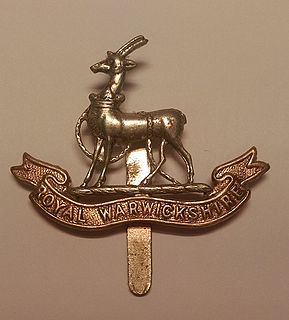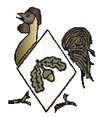Related Research Articles

The 61st Division was an infantry division of the British Army raised in 1915 during the Great War as a second-line reserve for the first-line battalions of the 48th Division. However, the division was sent to the Western Front in May 1916 and served there for the duration of the First World War.

The 8th Infantry Division was an infantry division of the British Army that was active in both the First and Second World Wars. The division was first formed in October 1914 during the First World War, initially consisting mainly of soldiers of the Regular Army and served on the Western Front throughout the war, sustaining many casualties, before disbandment in 1919. The division was reactivated in Palestine, under the command of Major-General Bernard Montgomery, in the late 1930s in the years running up to the Second World War before being disbanded in late February 1940. It was briefly reformed in Syria in an administrative role during 1942-3.

The 19th (Western) Division was an infantry division of the British Army, part of Kitchener's Army, formed in the Great War.

The Royal Warwickshire Regiment, previously titled the 6th Regiment of Foot, was a line infantry regiment of the British Army in continuous existence for 283 years. The regiment saw service in many conflicts and wars, including the Second Boer War and both the First and Second World Wars. On 1 May 1963, the regiment was re-titled, for the final time, as the Royal Warwickshire Fusiliers and became part of the Fusilier Brigade.

The 17th Infantry Brigade was an infantry brigade formation of the British Army which provided active service in the Second Boer War and both the First and Second World Wars. It was mainly composed of Regular Army battalions.

The 40th Division was an infantry division of the British Army active during the First World War, where it served on the Western Front. It was a division of Lord Kitchener's New Army volunteers, mostly "bantam" recruits of below regulation height. It was later briefly reformed as a fictional deception formation in the Second World War, and during the early years of the Cold War was recreated a third time to garrison Hong Kong.

The Sherwood Foresters was a line infantry regiment of the British Army in existence for just under 90 years, from 1881 to 1970. In 1970, the regiment was amalgamated with the Worcestershire Regiment to form the Worcestershire and Sherwood Foresters Regiment, which in 2007 was amalgamated with the Cheshire Regiment and the Staffordshire Regiment to form the present Mercian Regiment. The lineage of the Sherwood Foresters is now continued by The Mercian Regiment.
The Warwickshire Yeomanry was a yeomanry regiment of the British Army, first raised in 1794, which served as cavalry and machine gunners in the First World War and as a cavalry and an armoured regiment in the Second World War, before being amalgamated into the Queen's Own Warwickshire and Worcestershire Yeomanry in 1956. The lineage is maintained by B Squadron, part of The Royal Yeomanry.

The Wiltshire Regiment was a line infantry regiment of the British Army, formed in 1881 under the Childers Reforms by the amalgamation of the 62nd (Wiltshire) Regiment of Foot and the 99th Duke of Edinburgh's (Lanarkshire) Regiment of Foot.

The Worcestershire Regiment was a line infantry regiment in the British Army, formed in 1881 under the Childers Reforms by the amalgamation of the 29th (Worcestershire) Regiment of Foot and the 36th (Herefordshire) Regiment of Foot. The regiment fought in many conflicts, including both the First and Second World Wars, until 1970, when it was amalgamated with the Sherwood Foresters to form the Worcestershire and Sherwood Foresters Regiment. In September 2007, the regiment amalgamated with the Cheshire Regiment and the Staffordshire Regiment to form the Mercian Regiment.

The 21st Brigade was an infantry brigade formation of the British Army.

The 165th (Liverpool) Brigade was an infantry brigade of the British Army that served during the First World War, with the 55th Division. During the Second World War, as part of the 55th Infantry Division, the brigade remained in the United Kingdom.
The 74th Brigade was a formation of the British Army. It was raised as part of the new army also known as Kitchener's Army and assigned to the 25th Division and served on the Western Front during the First World War. After suffering heavy losses in the German Spring Offensive in 1918 the brigade was reformed with new units. It fought on the Hindenburg Line in October and in Picardy in November.
The brigade was not reformed for the Second World War.
The 63rd Brigade was a formation of the British Army. It was raised as part of the new army also known as Kitchener's Army and assigned to the 21st Division and served on the Western Front during the First World War. In July 1916 the brigade was transferred to the 37th Division.

The 88th Brigade was an infantry brigade formation of the British Army, raised for service in the First World War. It was originally formed from regular army battalions serving away from home in the British Empire. The brigade was assigned to the 29th Division and served on the Western Front and the Gallipoli Campaign and in the Middle East.
The 100th Brigade was a formation of the British Army founded during World War I. It was raised as part of the new army also known as Kitchener's Army and assigned to the 33rd Division. The brigade served on the Western Front. The brigade saw additional action during Britain's involvement in Vietnam following the Second World War.

The 182nd Brigade was an infantry brigade of the British Army that saw active service in World War I with the 61st Division and remained in the United Kingdom throughout World War II, serving with the 61st Infantry Division.

The 183rd Brigade was an infantry brigade formation of the British Army.

The British yeomanry during the First World War were part of the British Army reserve Territorial Force. Initially, in 1914, there were fifty-seven regiments and fourteen mounted brigades. Soon after the declaration of war, second and third line regiments were formed. However, the third line regiments were soon absorbed into the Cavalry Reserve Regiments, to supply replacements for the cavalry and yeomanry. Other horsed regiments in the British Army, during the war, were the regular cavalry regiments and the three regiments belonging to the special reserve: the North Irish Horse, the South Irish Horse and the King Edward's Horse. The senior yeomanry regiments could trace their origins back over 100 years; the oldest regiment, the Royal Wiltshire Yeomanry, had been formed in 1794. The most junior regiment, the Welsh Horse, had only been formed on 18 August 1914, after the start of the war.

The 144th Infantry Brigade was an infantry brigade of the British Army that saw active service in World War I and again in the early stages of World War II before being reduced to a reserve brigade and remained in the United Kingdom for the rest of the war. In both world wars the brigade served with 48th Division.
References
- ↑ "19th (Western) Division". The Long Long Trail. Retrieved 20 January 2012.
| This article about a specific British military unit is a stub. You can help Wikipedia by expanding it. |